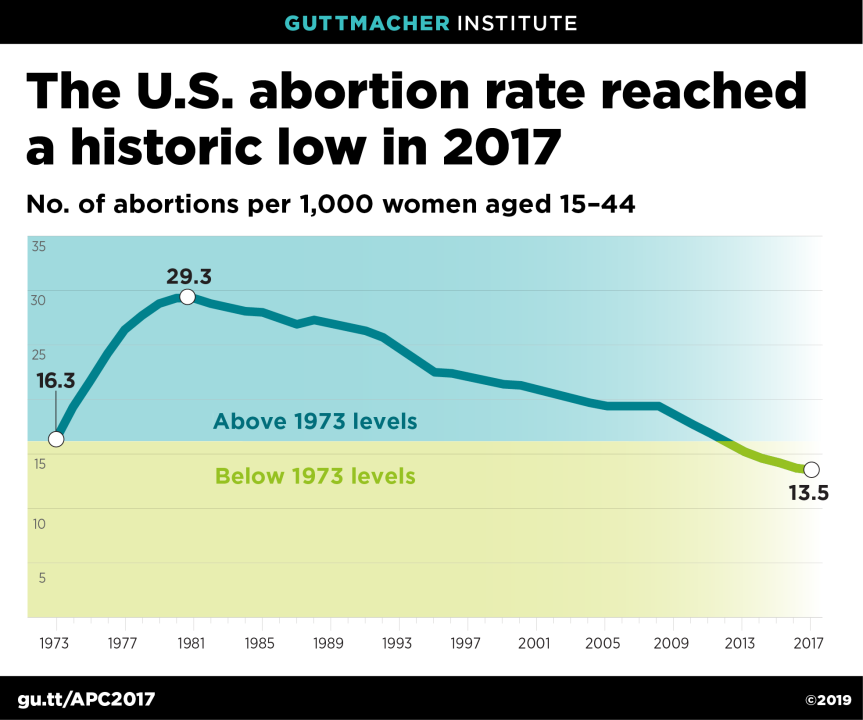The U.S. abortion rate dropped to 13.5 abortions per 1,000 women aged 15–44 in 2017, the lowest rate recorded since abortion was legalized in 1973 and an 8% decline from 2014, according to a new Guttmacher report by Rachel Jones, Elizabeth Witwer and Jenna Jerman. The number of abortions also declined to 862,320 in 2017, 7% fewer than in 2014. Birthrates declined in almost all states during this period, indicating that fewer people became pregnant, not that more individuals chose or were made to give birth rather than have an abortion.
The Guttmacher Institute’s 18th census of all known abortion-providing facilities in the United States identified 808 clinic facilities providing abortions in 2017, a 2% increase from 2014. However, during that time, longstanding regional and state disparities in abortion access grew even more pronounced: The number of clinics increased in the Northeast (by 16%) and the West (by 4%) and actually decreased in the Midwest (by 6%) and the South (by 9%). In 2017, 89% of U.S. counties did not have a clinic that provided abortion services, and 38% of women of reproductive age lived in these counties.
Despite the continued onslaught of state abortion restrictions, particularly in the Midwest and South, these restrictive policies do not appear to be the primary driver of declining abortion rates, as there is no consistent relationship between increases or decreases in clinic numbers and changes in state abortion rates. In fact, abortion rates declined in all four regions and in most states.
"Abortion laws affect those seeking services. Restrictions create barriers to access that can make it more difficult for already marginalized individuals, who may need to travel further or forgo other necessities to get the care they need. Protective laws can ensure people have access to abortion when they need it," says Elizabeth Nash, the Guttmacher Institute’s state policy analyst.
As in previous years, clinics provided the majority (95%) of U.S. abortions, while private physicians’ offices and hospitals accounted for 5%. In 2017, the number of specialized abortion clinics—those in which at least half of patient visits were for abortion services—declined, while the number of nonspecialized clinics increased. This finding suggests that some clinics are offering a broader range of services, enabling their patients to access abortion and other reproductive health services in a single location.
While the overall number of U.S. abortions decreased from 2014 to 2017, the number and share of medication abortions provided by abortion clinics and other providers increased during this period. A total of 339,640 medication abortions occurred in 2017, a 25% increase from 2014. These accounted for 39% of all abortions in 2017. The proportion of clinics providing only medication abortion (as opposed to both medication abortion and surgical abortion procedures) also increased—from 26% to 30% of all clinic facilities—during this period.
The study also attempted to gauge whether an increasing share of abortions are happening outside of medical facilities and therefore would not be captured by this survey. In 2017, 18% of nonhospital facilities reported that they had seen any patients who had attempted to self-manage their abortion (i.e., to end a pregnancy on their own), an increase from 12% in 2014. Since 2014, the drugs misoprostol and mifepristone have become increasingly available over the Internet, as have websites that provide accurate information about how to safely and effectively self-manage abortion. While the overall number of self-managed abortions is difficult to quantify, the authors considered it unlikely that an increase in self-managed abortion could account for most of the national decline in abortion incidence during this study period.
"Abortion care is evolving to meet people’s needs and preferences," says Megan Donovan, Guttmacher policy expert. "It is important that policies and funding support these advances, so that individuals can access abortion in the way that works best for them."
